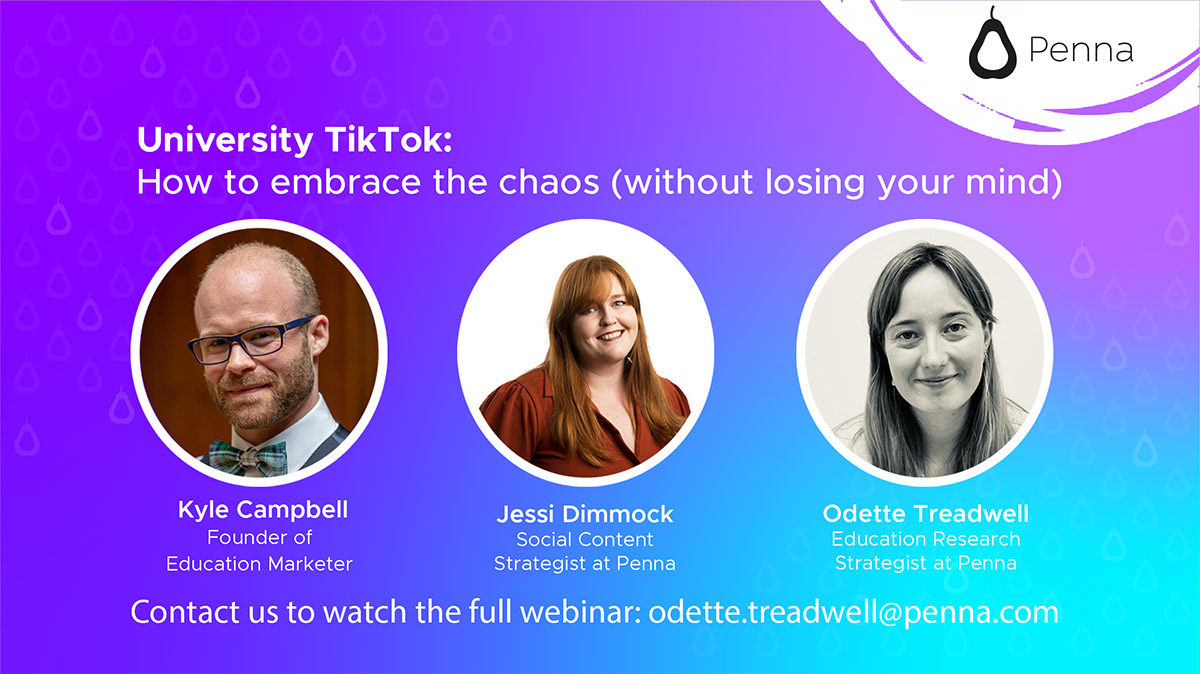
Our recent webinar revealed how Universities can harness the power of TikTok in their marketing campaign
TikTok is a tour-de-force of an app which has grown rapidly since its launch in 2016. Many have tried to bring it down, but it has only gone from strength to strength. With TikTok recording more than three times the engagement of other popular social media sites like Instagram, more businesses are realising just how useful the app can be as a marketing tool. ‘TikTok has the greatest stickiness of an app that we’ve ever seen’, exclaimed Founder of Education Marketer Kyle Campbell. Together with Jessi Dimmock, Social Content Strategist at Penna, and Odette Treadwell, Education Research Strategist at Penna, they sat down for an hour to discuss how beneficial the app can be when included in a university’s marketing plan. Here are some of the highlights from the session...
TikTok’s content is incredibly important, and it’s consumed in a completely different way from its social media competitors. While Instagram, Facebook and other social sites rely on the appeal of a creator’s name, TikTok provides content based on what consumers engage with, not whom they are subscribed to. Content is delivered to those who have shown an interest in similar videos, which is something universities need to acknowledge in order to build their audiences. TikTok’s content needs to be of a high quality to stand out from competitors, the quality of the content being shared on the platform needs to be strong and not rely on the creator’s brand to carry it.
Once TikTok consumers have discovered a brands content, the next step is keeping their attention. Consistency is key, so a creator needs a steady stream of high-quality videos regularly uploaded to the platform.
TikTok self-identifies as an entertainment platform hub, likening itself to Netflix, Disney+ and other streaming services. Its statistics back up this claim, with TheNetworkEc findings showing users on the platform for an average of over 25 hours a month. Therefore, those interested in sharing on the platform must remember that content needs to be different from what is shared on other social media sites. TikTok users aren’t looking for the highly polished content that can be found on Instagram, they like to see original content that has been well-planned and executed. For example, the University of Portsmouth had clearly thought about what a student might want answers to when they uploaded this Clearing video. Their audience responded with a view count of over 153,000 and 273 comments.
There has been a shift in how younger people search for information, making TikTok the go-to search engine for the new generation. According to Pew Research, 33% of TikTok users say that they regularly get their news from the app. Google’s internal data shows that nearly half of Gen Z uses TikTok and Instagram for searches, instead of Google.
Content creators should keep this fact in mind - sharing simple content that they believe will cater to their consumers needs can be very effective. Universities can do the same, creating and sharing content that they believe students will be searching for.
The importance of content creators, and how they can use TikTok is of great importance, as they can have immense consumer influence. A recent survey conducted with people between the ages of seven to fifteen showed the majority picked ‘Creator’ as their chosen career aspiration. These are people that users will gravitate to and choosing to work with creators throughout a campaign can prove to be incredibly beneficial. Kyle talked about how the Anglo-American University in Prague partnered with content creator ‘Shlyyzz’ to generate 61 applications.
It’s also a great way to showcase a university’s community. As Odette explained, Universities can work with unaffiliated creators to produce ‘lo-fi’, relatable content that gives consumers a sneak peek at the facilities of the University that they may soon be attending. For example, ‘Jas.Olivia’ has 7.9k followers and 437k video likes on TikTok, and regularly posts lifestyle videos showing what it is like to be a student at the University of Sheffield. This word-of-mouth advertising can be a great addition to a university’s marketing strategy as Gen Z highly value the thoughts and opinions of their peers.
TikTok advertising can be great – when used in the right way. TikTok advertising is brilliant for reaching and building target audiences. As Jessi explained, by creating six variations of the same advert and tweaking each one slightly to suit a certain audience, you can take advantage of TikTok’s algorithms. For the education sector specifically, it’s a great way for universities to target specific groups, such as female audiences or overseas students.
TikTok will only show adverts to those they think will watch the video for more than six seconds, so you can create content that caters to each audience and rest assured knowing that your content is being received by those who want to see it. Not sure how to create this content? Get in touch with Jessi.
The webinar was a massive hit, with most of our attendees choosing to stay past the allotted hour to engage and hear more on the subject. You can gain full access to the webinar by getting in contact with Odette from the Education Team via odette.treadwell@penna.com
